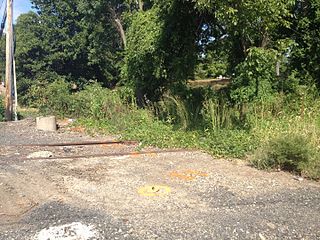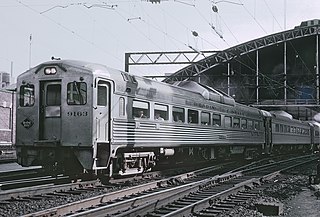
The SEPTA Regional Rail system is a commuter rail network owned by SEPTA and serving the Philadelphia metropolitan area. The system has 13 branches and more than 150 active stations in Philadelphia, Pennsylvania, its suburbs and satellite towns and cities. It is the sixth-busiest commuter railroad in the United States, and the busiest outside of the New York, Chicago, and Boston metropolitan areas. In 2016, the Regional Rail system had an average of 132,000 daily riders and 118,800 daily riders as of 2019.

The Wilmington/Newark Line is a route of the SEPTA Regional Rail commuter rail system in the Philadelphia area. The line serves southeastern Pennsylvania and northern Delaware, with stations in Marcus Hook, Pennsylvania, Wilmington, Delaware, and Newark, Delaware. It is the longest of the 13 SEPTA Regional Rail lines.

Walnut Hill station is a defunct SEPTA Regional Rail station in Abington Township, Montgomery County, Pennsylvania. Located on Moredon Road, it served the Fox Chase/Newtown Line. SEPTA closed the station in 1983.

Huntingdon Valley station is a former SEPTA Regional Rail station in Lower Moreland Township, Pennsylvania. It was located on Terwood Road near Old Welsh Road and served the Fox Chase/Newtown Line. SEPTA closed the station in 1983, and the shelter was subsequently demolished.

Bryn Athyn station is a former railroad station in Bryn Athyn, Pennsylvania. Built by the Reading Railroad, it later served SEPTA's Fox Chase/Newtown Line. It is located on Fetters Mill Road near the Pennypack Creek. The station is a contributing property to the Fetter's Mill Village Historic District.

County Line station is a derelict SEPTA Regional Rail station in Upper Southampton Township, Pennsylvania. It served a now-abandoned segment of the Fox Chase Line, and was located on County Line Road near the County Line Industrial Park.

Churchville station is a former train station in Churchville, Pennsylvania. Still owned by SEPTA and located on Knowles Avenue and Bustleton Pike, it is now a leased private residence.

Holland station is a defunct railroad station in Holland, Pennsylvania. Located on Holland Road, it served the Reading Railroad and later SEPTA Regional Rail's Fox Chase/Newtown Line. SEPTA cancelled railroad service in 1983; buses continued to stop at the station in 1999, and the facility was subsequently demolished.

George School station is a defunct railroad station at George School, a private Quaker boarding and day high school in Middletown Township, Bucks County, Pennsylvania. The original station was built by the Philadelphia, Newtown and New York Railroad in 1893 and burned in 1905. It was replaced with a station that was moved from Huntingdon Valley, further down the Newtown Branch. That station was demolished in 1971. A cinder 'platform' was used as a flagstop by both the Reading Railroad and SEPTA Regional Rail. SEPTA closed the station and several others in 1983 when train service was suspended.

Newtown station is a defunct railroad station in Newtown, Bucks County, Pennsylvania. Built by the Reading Railroad, it later served SEPTA Regional Rail's Fox Chase/Newtown Line. SEPTA closed the station in 1983.

Huntingdon Valley is a village, as well as a suburban mailing address located in Lower Moreland Township, Upper Moreland Township and Abington Township all in Montgomery County, and in small sections of Upper Southampton Township and Lower Southampton Township in Bucks County, Pennsylvania, United States, bordering the Fox Chase, Bustleton, and Somerton sections of Philadelphia.

The Warminster Line is a route of the SEPTA Regional Rail commuter rail system. It serves stations between its namesake town, Warminster, and Center City Philadelphia. Half of the route is shared by other lines, including the Lansdale/Doylestown Line, West Trenton Line, Fox Chase Line, Chestnut Hill East Line, and Manayunk/Norristown Line. All trains continue as part of the Airport Line with the exception of some weekday trains that terminate at 30th Street Station, Thorndale, or Trenton Transit Center.

The West Trenton Line is a SEPTA Regional Rail service connecting Center City Philadelphia to the West Trenton section of Ewing Township, New Jersey.

The Media/Wawa Line is a SEPTA Regional Rail service that runs from Center City Philadelphia west to Wawa in Delaware County. It uses the West Chester Branch, which connects with the SEPTA Main Line at 30th Street Station. Under the Pennsylvania Railroad, service continued to West Chester, Pennsylvania. On September 19, 1986, however, service was truncated to Elwyn.

The Fox Chase Line is a SEPTA Regional Rail service connecting Center City Philadelphia with Fox Chase. It uses the Fox Chase Branch, which branches off from the SEPTA Main Line at Newtown Junction north of the Wayne Junction station. It runs entirely within the city of Philadelphia. The line is fully grade-separated, except for one grade crossing on Oxford Avenue.

The Chestnut Hill West Line is a commuter rail line in the SEPTA Regional Rail network. It connects Northwest Philadelphia, including the eponymous neighborhood of Chestnut Hill, as well as West Mount Airy and Germantown, to Center City.

Silverliner is the name given to a series of electric multiple unit (EMU) railcars in commuter rail service in the Philadelphia area since 1958. As of the introduction of the Silverliner V in 2009–2010, there have been 5 generations of Silverliner cars, identified by the Roman numerals I through V placed after the name Silverliner. The Silverliner name came from the classes' shiny stainless steel body shell, which contrasted with the painted and frequently rusting carbon steel railcars used by the Pennsylvania and Reading Railroads between 1915 and 1936. Applied to the first large production order in 1963, the cars made such an impression that the name has since been applied to all subsequent MU classes purchased by SEPTA for the Regional Rail services.

The Pennypack Trail is a rail trail located in eastern Montgomery County, Pennsylvania in the United States. The trail runs 6.2 miles (10.0 km) from Rockledge north to the County Line Road border with Bucks County in Huntingdon Valley along the former alignment of SEPTA's Fox Chase-Newtown Line. The trail is maintained by the Montgomery County Division of Parks, Trails, & Historic Sites.
The Fox Chase Branch, formerly the Newtown Branch, is a railway line in the state of Pennsylvania. It runs 4.9 miles (7.9 km) from a junction with the SEPTA Main Line near Wayne Junction to Fox Chase. At its fullest extent, it continued another fifteen miles north to Newtown. The oldest part of it was built in 1876 by the Philadelphia, Newtown and New York Railroad. It was part of the Reading Company system from 1879 until 1976. Today it is owned by SEPTA and hosts the Fox Chase Line commuter rail service.

The Pottsville Line was a commuter rail service in the Delaware Valley, connecting Pottsville, Reading, and Pottstown with Philadelphia. It was the last vestige of passenger service on the former Reading main line. The service lasted into the SEPTA era and was discontinued in 1981. SEPTA continues to operate Manayunk/Norristown Line commuter trains between Philadelphia and Norristown.




















